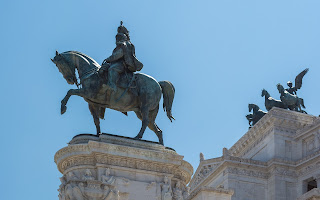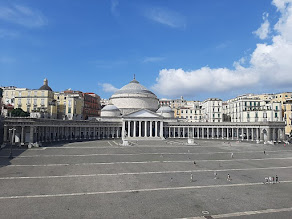TV reporter murdered in Somalia ambush
The TV journalist Ilaria Alpi, who with her Italian cameraman Miran Hrovatin was murdered while reporting from war-torn Somalia in the early 1990s, was born on this day in 1961 in Rome..jpg)
Ilaria Alpi's reports from war zones in Africa and
the Middle East were a feature of Tg3 news coverage
Alpi, who was in Somalia for Italy’s national broadcaster Rai as the United Nations attempted to end a three-year long civil war in the country, was killed near the Hotel Sahafi, which was the international media base in the Somali capital Mogadishu.
The pick-up in which she and Hrovatin were travelling was at a crossroads about 4.5km (2.8 miles) from the Sahafi when a Land Rover pulled across their path, forcing their vehicle to stop. At this point a gunman or several gunmen - as many as seven, some reports said - began shooting. Alpi and Hrovatin died at the scene, although their driver and three armed bodyguards escaped unhurt.
The murders shocked Italy, where viewers had been used to seeing Alpi’s reports on the Tg3 news programmes from Lebanon and Kuwait as well as Somalia. She had a deep knowledge of the area and was fluent in Arabic languages.
She had been in Somalia regularly to report on the United Nations’ attempts to bring order and peace to the country via Restore Hope, a peacekeeping mission launched in response to the civil war that had been ongoing for a number of years.
What was to be her final, fateful visit had begun only two weeks earlier when she was sent to cover the effective abandonment of the mission with the withdrawal of the American contingent, ordered by President Clinton following an escalation in UN casualties.
.jpg) |
| Alpi with her regular cameraman Miran Hrovatin, who also died in the attack |
Although the motive for the murders of Alpi and Hrovatin have never been established (and a Somali suspect convicted of the killings eventually released and compensated for wrongful imprisonment), it is thought that parallel to her coverage of the UN peace mission, Alpi had been investigating suspected illegal arms trafficking between Italy and Somalia as well as the dumping of toxic and even nuclear waste shipped from Italy.
In the days before the murders, she and Hrovatin had travelled almost 1,400 miles north to the port of Bosaso on the Gulf of Aden to interview Abdullah Moussa Bohor, a local so-called sultan.
Alpi had reportedly told the newsroom at Tg3 to expect to receive interviews she had conducted, the content of which was “too big and important” to discuss on the telephone.
On the afternoon of Sunday, March 20, 1994, witnesses who recall speaking to Alpi at the Hotel Sahafi said that she left hurriedly to see a contact at another hotel in the north of Mogadishu and that it was on her way back from this meeting that she was gunned down.
 |
| Alpi had been a student of Arabic and Islamic culture before she became a journalist |
The most popular theory was that Bohor had told them about an Italian-Somalian fishing company whose vessels had been involved in shipping arms from factories in northern Italy to be sold illegally to Somali’s armed militia groups, as well as transferring toxic waste to be buried in the desert, and that they had even been shown one of the vessels.
The theory was reinforced by the presence at the murder scene soon after the shooting had taken place of an Italian entrepreneur based in Mogadishu with previous links to the arms trade in Somalia. The bodies of Alpi and Hrovatin were removed from the scene on one of his trucks prior to their return to Italy. Notebooks and video cassettes that were among the possessions recovered at the scene had mysteriously disappeared by the time the bodies arrived in Rome.
The entrepreneur, who was never accused of any crime in relation to his presence, allegedly offered a view that the attack was unlikely to have been an attempt to steal their truck, as was reported at the time, but that the two journalists had “probably seen something they were not meant to see”.
Alpi’s parents, Giorgio and Luciana, both of whom are now dead, campaigned tirelessly to find the truth about what happened to their daughter.
.jpg) |
| Many parts of Mogadishu still bear the scars of years of conflict in the Somalian region |
A further twist involved an Italian secret service operative, Vincenzo Li Causi, who had died in mysterious circumstances a few months earlier. Li Causi, a contact of Alpi, was a member of Gladio, the undercover operation set up by the Americans to remain in Italy after World War Two, primarily as a bulwark against the potential advance of communism in the country.
Alpi entered journalism after graduating from Rome’s Sapienza University, where she studied literature and languages and Islamic culture. Fluent in English, French and Arabic, she freelanced for various newspapers and radio stations before being appointed as a correspondent in Cairo for the newspapers Paese Sera and L’Unità.
She joined Rai in 1990, initially for the RaiSat international channel before being assigned to Tg3, the news arm of Rai Tre.
Ilaria Alpi’s memory lives on in a large number of streets, squares, gardens and buildings carrying her name and that of her cameraman Miran Hrovatin in towns and cities across Italy.
In popular culture, numerous books have been written and films made about her life, including the award-winning Ilaria Alpi - Il più crudele dei giorni (Ilaria Alpi - The Cruellest of Days), directed by Ferdinando Vicentini Orgnani and starring Giovanna Mezzogiorno as Ilaria.
An Ilaria Alpi Prize was established for the best Italian television investigations dedicated to the themes of peace and solidarity.
Travel tip:
The University of Rome was given a modern
new campus designed by Marcello Piacentini
The University of Rome, where Ilaria Alpi studied, is often referred to as the Sapienza University of Rome or simply La Sapienza, meaning 'knowledge'. It was founded in 1303 by Pope Boniface VIII, as a place for ecclesiastical studies over which he could exert greater control than the already established universities of Bologna and Padua. The first pontifical university, it expanded in the 15th century to include schools of Law, Medicine, Philosophy and Theology. Money raised from a new tax on wine enabled the University to buy a palace, which later housed the Sant'Ivo alla Sapienza church. The University was closed during the sack of Rome in 1527 but reopened by Pope Paul III in 1534. In 1870, La Sapienza ceased to be the papal university and as the university of the capital of Italy became recognised as the country's most prestigious seat of learning. A new modern campus was built in 1935 under the guidance of the architect Marcello Piacentini.
Travel tip:The headquarters building of Rai, Italy's national
TV network, in Rome's Viale Mazzini
The Rome headquarters of Rai, Italy’s national television network, can be found in Viale Giuseppe Mazzini, where the company has been based since 1966. It is in the elegant neighbourhood called Della Vittoria, immediately north of the Prati neighbourhood, which contains the Stadio Olimpico. Originally called Milvio when it was established in 1921 and was given its present name only in 1935 to honour Italy’s victory in the First World War. Many of the area’s streets are named after heroes of the Risorgimento and the First World War. Piazza Mazzini, the area’s most important square, is just a few steps from the Rai building, in front of which is a striking bronze horse by the Sicilian sculptor Francesco Messina. The sculpture was meant to represent power and strength, yet is now commonly known as ‘the dying horse’ after a journalist wrongly thought the signs of deterioration were meant to be wounds, creating an alternative name that caught on.
Also on this day:
1494: The birth of painter Jacopo Carucci di Pontormo
1671: The birth of Gian Gastone de’ Medici
1751: The birth of Charles Emmanuel IV, King of Sardinia
1847: The birth of inventor Alessandro Cruto
1949: The birth of film producer Aurelio De Laurentiis
1981: The birth of TV chef Simone Rugiati









.jpg)

